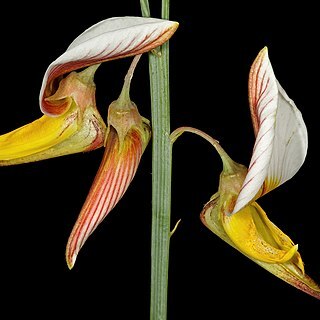Standard whitish inside, white or yellow and lined reddish-brown outside, glabrous to pubescent; wings yellow, shorter than the keel; keel (1.3)1.4–1.7 cm long, angled in the lower part with a long straight beak, darker at the tip.
Leaves all 1-foliolate or a few middle ones 3-foliolate, estipulate; leaflets 7–50 × 0.8–9 mm, linear to linear-lanceolate or-oblanceolate, with basal lateral nerves ascending well into the upper half; petioles mostly 6–18 mm long.
Racemes laxly 6–12-flowered; bracts 1–4 mm long, linear to linear-lanceolate; bracteoles variously inserted on the 6–10 mm long pedicel, small.
Calyx 5–7 mm long, glabrous to sparsely puberulous; lobes subulate to narrowly triangular-acuminate, ± as long as the tube.
Erect virgate herb or subshrub, 0.4–1 m tall; branches glaucous, ribbed, subglabrous to sparsely strigulose.
Pod subsessile, 10–16 × 6–7 mm, oblong-ellipsoid to shortly cylindrical, 4–8-seeded.
Seeds c. 3 mm long, oblique-cordiform, papillate, brown.

